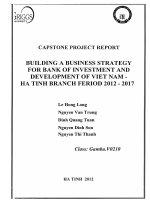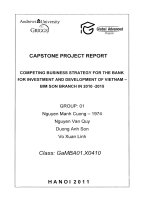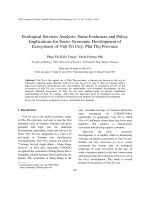Development of a palpable virtual nylon thread and handling of bifurcations
Bạn đang xem bản rút gọn của tài liệu. Xem và tải ngay bản đầy đủ của tài liệu tại đây (1.02 MB, 71 trang )
DEVELOPMENT OF A PALPABLE VIRTUAL NYLON THREAD
AND HANDLING OF BIFURCATIONS
ANKUR DHANIK
(Bachelor of Technology, IIT Kanpur, India)
A THESIS SUBMITTED FOR
THE DEGREE OF MASTERS OF ENGINEERING
DEPARTMENT OF MECHANICAL ENGINEERING
NATIONAL UNIVERSITY OF SINGAPORE
2005
To my grandparents and parents
Acknowledgements
I wish to express my deepest gratitude and appreciation to my supervisors, Dr.
Etienne Burdet and Dr. Teo Chee Leong for their instructive guidance and constant personal encouragement during every stage of this research. I greatly respect
their inspiration, unwavering examples of hard work, professional dedication and
scientific ethos.
I am highly indebted to Dr. Tim Poston, NIAS, India for his continued involvement in my research. He was always the light at the end of a dark tunnel. His
mathematical expertise and wide range of knowledge and experience, were always
useful. It was great to work with him and learn so many things.
I would like to thank my parents, brother and sister for their continued love and
support at every stage of my life.
I gratefully acknowledge the financial support provided by the National University
of Singapore through Research Scholarship that makes it possible for me to study
for academic purpose.
My gratitude also goes to Mr. Yee Choon Seng, Mrs. Liaw , Mrs. Too, Mrs.
Ooi, Ms. Tshin, Ms. Salmah and Mr. Zhang for the helps on facility support in
the laboratory so that the project may be completed smoothly.
Last but not the least I will like to thank people with whom I enjoyed a lot
iii
collaborating during my research. I thank Wang Fei for his thoughts, ideas and
providing motivation. I also thank Dr. Lim Kian Meng, James K Rappel, Teo
Cheng Yong William, Ganesh Gowrishankar, Brice Rebsamen and Long Bo for
their inputs and ideas. I was lucky to have a bunch of friends who always kept me
cheerful. I thank Tirthankar Bandopadhyay, Naveen Agarwal, M K Saravanan,
Ashok M. Prabhu, Desingh Devibalan Balasubramaniam, Dr. K. Bhupal Redddy,
Talasila Sateesh, Li Yuan Ping, Koh Niak Wu, Beatrice and Nandagopal for the
nice time spent together.
iv
Table of contents
Acknowledgements
iii
Abstract
viii
List of Figures
ix
1 Introduction
1
2 Handling Bifurcations in Haptics
2.1 Introduction . . . . . . . . . . . . . . . . . . . . . . . . . . . . .
2.2 Instability Studies . . . . . . . . . . . . . . . . . . . . . . . . . .
2.3 Elastic buckling . . . . . . . . . . . . . . . . . . . . . . . . . . .
2.3.1 Elastic curve model . . . . . . . . . . . . . . . . . . . . .
2.3.2 Equilibrium surface . . . . . . . . . . . . . . . . . . . . .
2.3.3 Zeeman machine . . . . . . . . . . . . . . . . . . . . . .
2.3.4 Haptic forces on the controls . . . . . . . . . . . . . . . .
2.3.5 Computational instability . . . . . . . . . . . . . . . . .
2.4 Multi-variable states . . . . . . . . . . . . . . . . . . . . . . . .
2.4.1 Curved separation of quadratic and degenerate directions
2.4.1.1 Two internal variables . . . . . . . . . . . . . .
2.4.1.2 Non-axis degeneracy . . . . . . . . . . . . . . .
2.4.1.3 Multiple internal variables . . . . . . . . . . . .
2.4.2 Around a bifurcation point . . . . . . . . . . . . . . . . .
2.5 Experiments and Results . . . . . . . . . . . . . . . . . . . . . .
2.6 Discussion . . . . . . . . . . . . . . . . . . . . . . . . . . . . . .
3 Palpable Virtual Nylon Thread
3.1 Introduction . . . . . . . . . . . . . . .
3.2 Literature review . . . . . . . . . . . .
3.3 Development of nylon thread dynamics
3.3.1 Geometric Descriptors . . . . .
3.3.2 Dynamics . . . . . . . . . . . .
3.4 Experiments and Results . . . . . . . .
3.5 Discussion . . . . . . . . . . . . . . . .
.
.
.
.
.
.
.
.
.
.
.
.
.
.
.
.
.
.
.
.
.
.
.
.
.
.
.
.
.
.
.
.
.
.
.
.
.
.
.
.
.
.
.
.
.
.
.
.
.
.
.
.
.
.
.
.
.
.
.
.
.
.
.
.
.
.
.
.
.
.
.
.
.
.
.
.
.
.
.
.
.
.
.
.
.
.
.
.
.
.
.
.
.
.
.
.
.
.
.
.
.
.
.
.
.
.
.
.
.
.
.
.
.
.
.
.
.
.
.
.
.
.
.
.
.
.
.
.
.
.
.
.
.
.
.
.
.
8
8
11
12
12
13
15
18
20
21
23
24
27
28
32
33
37
.
.
.
.
.
.
.
39
39
40
41
42
43
46
49
4 Conclusion
51
References
53
v
Appendices
54
A k-determinacy
55
B Splitting Lemma
56
C Transversality
59
D The Morse Lemma
60
vi
Abstract
This research is motivated by a need to simulate surgical suturing which will be
used in a microsurgery training system currently under development in a collaboration between Control and Mechatronics laboratory, NUS and National University
Hospital. We have developed a palpable (the thread can be felt using a haptic
device) virtual nylon thread, which will be used in suturing training. This work
on thread led to discovery of problem of vibrations in haptics when bifurcations
are encountered. We have developed a novel technique to handle bifurcations in
haptics. The usual numerical techniques involve using second order Taylor series
approximation for energy of the system, and finding the equilibria using standard
Newton’s method. This fails near bifurcations, places where number of available
equilibria change suddenly. And leads to vibrations when feeling such a system
using haptic techniques. We use higher order energy approximation to solve this
problem. We show that higher order terms are necessary, but using bifurcation
theory prove that third and fourth derivatives of energy (second and third of force)
are sufficient.
We model first a single variable system which bifurcates, a Zeeman machine.
To our knowledge this is the first haptic realization for it. We demonstrate using
Zeeman machine that using third and fourth derivatives in energy approximation,
leads to elimination of vibrations . For a multi-variable system, like a 2D elastic
curve, which simulates a tape-like thread which has preferred plane of bending, the
number of third and fourth derivatives are huge and finding all of them is computationally expensive, an important consideration in haptics for avoiding vibrations
due to delayed response. We make use of splitting lemma and prove that it is suf-
vii
ficient to look for higher derivatives along a specific direction. This significantly
reduces the computational load as the higher derivatives can be found easily using
numerical differentiation along this direction. The results demonstrate that the
algorithm works excellently well.
We have developed an energy based method for simulating a nylon thread.
The nylon thread is an example of non-linear dynamics. It shows phenomenon
such as bifurcations, leading to ‘snap-through’ jumps and large flexible deformation, which is in essence of knotting. We model the thread energy using stretching
and bending energies, and find equilibria. The algorithm developed for handling
bifurcations is applied, and works extremely well. We successfully demonstrate
the phenomena associated with a real nylon thread in our virtual thread. Smooth
haptic experience is also achieved. A full description of thread will require inclusion of twisting energy and self-collision detection, and will be dealt with in
future. Nevertheless, our technique for the first time brings out the characteristic
features associated with a nylon thread, which are ignored sometimes for more
visual realism.
viii
List of Figures
1.1
1.2
1.3
1.4
Right topology for loop formation . . . . . . . . . . . . . .
Equilibrium states and bifurcation . . . . . . . . . . . . . .
Elimination of unphysical chatter at snap points . . . . . .
A user manipulating virtual nylon thread using PHANToM
device. . . . . . . . . . . . . . . . . . . . . . . . . . . . . .
. . . .
. . . .
. . . .
haptic
. . . .
2.1
2.2
2.3
2.4
2.5
.
.
.
1
3
6
.
7
Buckling of a tape-like thread . . . . . . . . . . . . . . . . . . . .
Two-dimensional elastic curve model. . . . . . . . . . . . . . . . .
The Zeeman machine . . . . . . . . . . . . . . . . . . . . . . . . .
The equilibrium surface . . . . . . . . . . . . . . . . . . . . . . .
Vibration experienced in thread, Zeeman machine and standard
cusp simulation . . . . . . . . . . . . . . . . . . . . . . . . . . . .
2.6 Newton’s method . . . . . . . . . . . . . . . . . . . . . . . . . . .
2.7 Higher-order computed equilibria for the Zeeman machine and standard cusp . . . . . . . . . . . . . . . . . . . . . . . . . . . . . . .
2.8 Curve on which equilibria lie . . . . . . . . . . . . . . . . . . . . .
2.9 Equilibria convergence . . . . . . . . . . . . . . . . . . . . . . . .
2.10 Force profiles obtained while moving the control point of 2D curve
2.11 Refresh rate as a function of number of internal variables . . . . .
. 9
. 12
. 14
. 17
.
.
.
.
.
22
25
34
35
36
3.1
3.2
3.3
3.4
3.5
3.6
.
.
.
.
.
.
41
42
46
47
48
48
Pressing down a compressible upright . . . . . . . .
Three dimensional curve model . . . . . . . . . . .
Creating a loop . . . . . . . . . . . . . . . . . . . .
Snap sequence . . . . . . . . . . . . . . . . . . . . .
3D thread smooth haptics . . . . . . . . . . . . . .
Refresh rate vs number of segments in thread model
.
.
.
.
.
.
.
.
.
.
.
.
.
.
.
.
.
.
.
.
.
.
.
.
.
.
.
.
.
.
.
.
.
.
.
.
.
.
.
.
.
.
.
.
.
.
.
.
. 20
. 21
ix
Chapter 1
Introduction
Many studies have investigated interaction with, walls, hard surfaces, soft textured
surfaces, springy frictional surfaces. These are always surfaces of fixed shape, and
the local deformation depends on the user’s current input. On the other hand
many simulations - for example surgery - involve large scale changes of shape.
Pull a membrane, tear it off a gall bladder and you feel where it is still attached,
inches away. Pulling and pushing a nylon thread, such as that used in suturing
is a simpler but similar problem. The forces depend on the current shape and
the user’s input history. The current shape changes smoothly, but sometimes it
jumps.
Surgical simulation [2] requires simulating suturing process, wherein the surgeon manipulates a nylon thread to form a surgical knot. To make this thread
palpable, by which we mean that the thread can be felt using a force feedback
haptic device, dynamics based simulation of thread is required. Where a suture
G
(a)
G
(b)
G
(c)
Figure 1.1: The surgeon must create exactly the right loop (c) to reach through
for a knot, and does not trace its curve through the air, in contrast to knot tying
simulation based on geometry [1]. G refers to the grasped end of thread
1
needle creates a track in tissue that the suture thread must follow, it is enough to
define a curve [1] by pulling a needle through it. However, a key step in surgical
knotting is to grasp one thread with the left forceps and create a loop through
which the right forceps reach the other (Fig. 1.1). The first grasp taken far to the
left, pushes grasped point rightwards in untraced space. Nylon mechanics forms
the loop, to the right of any point where the forceps tip has gone. A ‘following
simulation’, where the thread is like a multi-linked chain with one node leading
rest of the nodes, does not match the task. This example shows the unavoidable
need to simulate the bending of an elastic curve fixed at one point and subject to
a changing user-controlled constraint at another. The shape must come from mechanics, not by geometric tracking, and the surgeon must master this mechanics including the propensity to snap.
A nylon thread exhibits snap-through jumps (Fig. 1.3A), which are caused
whenever it passes through energy bifurcation. Understanding of this phenomenon
requires first defining a few concepts:
Equilibrium: A physical system is said to be in equilibrium when the derivative
of its energy with respect to the variables of the system is equal to zero. A
physical system not disturbed by external forces always reaches its equilibrium state corresponding to a minimum of energy. A system can have single
or multiple equilibria.
Bifurcation: A system is said to bifurcate when the number of equilibrium states
available to it change suddenly, with very slight change in the system parameters. For example, a system can have two stable equilibria at a given
time, with the system resting in one of them, and on changing the system
parameters slightly one will vanish.
The red ball in Fig. 1.2 illustrates the variable which defines the state of the system.
The curves show the energy as a function of system variables, for a fixed set of
system parameters. In Fig. 1.2A, the system has three equilibria (three places on
the energy curve where derivative of energy is zero), and the system is in one of the
2
two local minima. With slight change in parameters, the equilibrium states of the
system change (Fig. 1.2B) and finally one stable minimum vanishes and the system
jumps to the remaining (now global) minimum (Fig. 1.2C). A similar phenomenon
is encountered when the tectonic plates of earth shift suddenly leading to massive
earthquakes [15] or when nylon thread undergoes snap-through jump.
A
B
C
Figure 1.2: Number of equilibrium states of the system changes near bifurcations.
In 3D simulation, just as with real nylon (Fig. 1.3), the shape taken by the
thread does not always change smoothly as G (the grasped end) smoothly moves.
This leads to a completely different class of problem in haptic simulation. Haptics
to date has generally concerned itself with systems where the response force F is
a function F (u) of the user’s immediate input u (t) at time t (typically a spatial
position (x, y, z), perhaps including orientation data for the grip, and sometimes
applied force, which may include torque). Ideally this would be an instantaneous
response — reasoning with Newton’s third law usually assumes that action and
reaction are equal, opposite, and also simultaneous — but real haptics prevents
this. Delayed response easily creates vibrations or chaos, and a large literature
has developed on preventing this. For example, [5], [6], [7], [8], [9], [10], [11]
discuss stability criteria for a force response law F (u), generally posing questions
equivalent to “If the user attempts to hold the device steady, or apply a steady
force, will the system converge to a steady state?”. We here address a different
source of instability, in a wider context, where the required returned force is a
function of input history (not merely of u (tnow ), but of previous events).
The problem of handling bifurcation related instabilities can be solved by using higher order Taylor series approximation of thread energy, used in the energy
3
minimizing scheme for simulating dynamics of thread. But in a multi-variable
system such as nylon thread it is not computationally feasible to calculate higher
derivatives in so many variables. This presents a technical challenge for the solution scheme that has to be devised. In the first part of this thesis, we use
‘quasi-static’ mechanics to bring out the role of bifurcation (change in the set of
available equilibria), and the ways that bifurcation theory can reduce the computational load, but emphatically preserving the ‘snap’ buckling instability which still
arises in such systems (Fig. 1.3). We illustrate this with the first haptic realization
of the Zeeman machine [12], an example with minimal degrees of freedom and an
elastic 2D curve, example with many degrees of freedom. By using the second
and third derivatives of force instead of only the first one as in usual algorithms,
we can suppress the physical shaking both in numerical tests and experimental
implementations [13].
Several schemes have been used to model a rope or nylon for simulating knot
tying. In [1] Joel Brown proposed a geometric approach to realize real time knot
tying, in which the rope is modelled as a series of nodes linked together. The
grasped node (the leader) is followed by rest of the nodes (followers) such that
the internodal length remains constant. This follow-the-leader approach leads to
a visually nice but (even visually) incorrect knot-tying simulation, because the
thread’s mechanics, which play an important role in loop formation (Fig. 1.1) are
not considered. A dynamic approach was recently developed in our lab [3],[4],
in which the nylon thread is modelled as a series of masses and springs. Springs
implement stretching, bending and twisting. When the grasped node is perturbed,
the nodes move in direction of resultant force at each node until the force is zero.
Real time simulation is achieved with this approach, with effects such as twisting
are realized, however essential non-linearities in the mechanics of thread such as
snaps have not been dealt with. The second part of this thesis describes details
of loop formation which involves minimization of thread’s energy. We develop a
3D curve as a paradigm for 3D thread. The 3D curve is broken into segments
and computationally simple bending and stretching energies are associated with
4
it. We find the equilibria of this system using the standard Newton method to
find equilibria of the thread subject to the constraints, which include the position
and direction of the grasped node and segment controlled using a PHANToM
haptic device(Fig. 1.4). Multiple equilibria lead to snap-through jumps which is
demonstrated by our nylon thread model as in Fig. 1.3C, 1.3D. When the currently
followed equilibrium vanishes, the nylon thread descends to another equilibrium
in a ‘snap-through’. The situation near bifurcations is handled with higher order
methods, where we use the scheme developed in the first part of this thesis, which
emphasizes its significance.
The thesis is organized as follows. Chapter 2 addresses the problem of vibrations near bifurcations , illustrates it on Zeeman machine and 2D curve, introduces
a novel scheme for handling bifurcations, thereby eliminating these vibrations,
and demonstrates its effectiveness. In Chapter 3 we describe energy based scheme
developed by us and our three dimensional thread model. We emphasize the application and significance of the scheme developed in Chapter 2 and demonstrate
the possibilities offered by the virtual thread.
5
20
8
15
6
force (N)
force(N)
10
5
0
2
0
-5
-2
-10
-4
-15
2600
4
2700
2800
2900
3000
grasp point position index
3100
3200
2000
2500
3000
grasp point position index
Figure 1.3: A manipulated nylon suture moves sometimes smoothly with
the forceps, sometimes jumps as the grip crosses an unseen boundary. A
shows this on a real nylon thread, and B in our simulation of a virtual nylon thread. C shows unphysical chatter at the snap points occuring when
using a standard Newton algorithm approach. We developed a novel approach based on bifurcation theory to successfully address this problem, as
is illustrated in D. Visualizing the movement requires movies available at
.
6
Figure 1.4: A user manipulating virtual nylon thread using PHANToM haptic
device.
7
Chapter 2
Handling Bifurcations in Haptics
2.1
Introduction
Haptics to date has generally concerned itself with systems where the response
force F is a function F (u) of the user’s immediate input u (t) at time t (typically a spatial position (x, y, z), perhaps including orientation data for the grip,
and sometimes applied force, which may include torque). Ideally this would be
an instantaneous response — reasoning Newton’s third law usually assumes that
action and reaction are equal, opposite, and also simultaneous — but real haptics
prevents this. Delayed response easily creates vibrations or chaos, and a large
literature has developed on preventing this. For example, [5], [6], [7], [8], [9],
[10], [11], discuss stability criteria for a force response law F (u), generally posing
questions equivalent to “If the user attempts to hold the device steady, or apply
a steady force, will the system converge to a steady state?”.
We in this thesis address a different source of instability, in a wider context,
where the required returned force is a function of input history (not merely of
u (tnow ), but of previous events). The system model includes an internal state σ
of positions, momenta, etc., whose dynamics σ˙ (σ, u) depends on the current state
but is also influenced by u, and response force F is a function F (u, σ) of both the
current input and the state which the system has reached. There can be instability
from a number of sources, notably:
8
2
1.5
1.5
-0.5
d
e
g
b
-1
a
h 0
-0.5
-1
-1.5
-2
-2
0.5
f
c
-1.5
-1
0
1
height of grasp point R ( )
-2
2
1.5
1
force(N)
0.5
2
1.5
1
yr
force(N)
1
0
2
1
0.5
0 d
-0.5
e
c
f
b
g
-1
a
h
0
-0.5
-1
-1.5
-2
-2
0.5
yr
2
-1.5
-1
0
1
height of grasp point R ( )
i
-2
2
j
Figure 2.1: We consider a more tape-like thread, whose buckling can stay in its
preferred-bending plane, with left end clamped. Moving the right end R vertically
causes snaps between ‘bent up’ and ‘bent down’ states a–h. Corresponding heights
for a reference point r on the curve jump up or down after R has crossed the midlevel. In i the evolution is tracked using our algorithms: j, computed by a standard
approach, shows unphysical chatter at the snap points. Related video is available
at [14].
1. The dynamics σ˙ may be oscillatory or chaotic even for constant u, and even
for the real system modelled. (A fibrillating heart feels chaotic, like a handful
of excited worms, and a simulation should feel the same.)
2. Delay in computing F may introduce inappropriate instability, in interaction
with the changes in u resulting from the user-side response law u˙ (u, F ).
(We include under u˙ such neuromotor effects as change in position under
the combined forces of the haptic device and the user’s muscles, tendons,
etc. These affect the dynamics even where force due to the user is not
mechanically sensed as an input to the haptics.)
3. Instability in computing σ,
˙ with consequent fluctuations in F (u, σ), even
if F has no impact on the evolution of u. This is particularly liable to
occur transiently where u is changing and the dynamics of σ˙ pass through a
9
bifurcation point. The convergence criterion used in much of the literature,
which assumes a user is not attempting to change σ, is unhelpful for such
transients.
We here address (3), barring oscillations and chaos by ‘quasi-static’ mechanics to
bring out the role of bifurcation, and the ways that bifurcation theory can reduce
the computational load, but emphatically preserving the ‘snap’ buckling instability
which still arises in such systems (Fig. 2.1). We compute the haptic response F ,
replacing F (u) by an implicit force law, but do not in our simulations allow u to
respond to it. For a clear focus on source (3), we change u in a pre-programmed,
unresponsive way and thus exclude (2), though user experiments with a real haptic
device cannot uphold such an exclusion. The physical shaking that prompted this
study is in fact suppressed in both our numerical and our experimental tests,
supporting the relevance of our analysis and the computational strategy it gives
rise to.
Most equilibria — vanishing points for force — are efficiently found by Newton’s method, based on the first derivative of force as a function of state. This linearization of force works well wherever the linear approximation is non-degenerate,
which is true near most individual equilibria. However, bifurcation occurs at points
where the linear approximation is degenerate, and in sustained interaction such
points can be topologically unavoidable. Buckling, in particular, is a feature of real
manipulated systems such as surgical stents and sutures, and buckling is rooted
in bifurcation.
We describe the system in which we first encountered this problem, and an
illustrative example (the ‘Zeeman machine’ [12] with minimal internal degrees of
freedom. In each case the reduction techniques of bifurcation theory show that
higher derivatives of force than the first become important numerically, but that
the second and third are sufficient: we illustrate this with a haptic realization of
the Zeeman machine. For n internal degrees of freedom, an energy-minimizing
force has n (n + 1) /2 first derivatives but n (n + 1) (n + 2) (n + 7) /24 second and
third, which would confine use of this to small systems, except that theory also
10
drastically limits the ones actually needed. We illustrate this with a 2D elastic
curve simulation.
2.2
Instability Studies
Most of the literature generally poses questions equivalent to “If the user attempts
to hold the device steady, or apply a steady force, will the system converge to a
steady state?” Fundamental stability and performance issues associated with haptic interaction are addressed in [5], [6]. Necessary and sufficient conditions for the
stability of a haptic simulation are developed, assuming the human operator and
virtual environment are passive. In the dissertation [7] and [8], [9], the problem
of guaranteed stability in the haptic display of virtual environments is addressed.
An implementation of stiff virtual wall is being focussed upon. A wall represents
boundary between zone of high stiffness and low stiffness. It has been observed
that humans are adept at adjusting their behavior to destabilize a virtual wall, if
possible. In other words, users will quickly find ways to setup a sustained or growing oscillations by gripping the haptic device lightly or firmly, as necessary. The
ability to set up oscillations is evidence of active walls: because the frequencies
of these oscillations are often outside the range of voluntary motion, and because
this behavior is not observed with physical walls, it is evident that the energy supply for the oscillations is the virtual wall, not the human. Suitable criteria have
been developed to make the wall passive. Colgate et.al. in [10] and [11] investigated non-linear mass/spring/damper virtual environments designed to prevent
oscillations in haptic display and other chaotic behavior in the signal presented to
human operator.
The scheme developed in this thesis is, to the best of our knowledge, the first
in haptics to address oscillations arising near bifurcations. No previous work for
comparison is available.
11
2.3
Elastic buckling
This study was prompted by work towards simulation of surgical suturing [2]. The
details of loop formation involve minimization of energy, an essentially 3D matter
discussed in detail in next chapter. The shape must come from the mechanics, not
by geometric tracking, and the surgeon must master this mechanics — including
the propensity to snap.
In 2D or 3D simulation (Fig. 2.1), just as with real nylon, the shape taken
by the thread does not always change smoothly as grasped end smoothly moves.
The change in the set of available equilibria (the bifurcation) that makes it jump
causes numerical failure, in techniques that work well at points of smooth behavior.
We take the 2D case here for clarity, as it well exemplifies snaps and continuous
buckling, and we can handle them without sacrificing haptic speed.
t
i+1
(xi , yi ) ti
(xi+1, yi+1 )
(x2, y2 )
(x0, y0 )
(x1, y1 ) t1
ti+2
P
(xn, yn )
tn
t2
Figure 2.2: Two-dimensional elastic curve model.
2.3.1
Elastic curve model
We here provide a brief insight into a 2D curve model, which is sufficient to
understand the concepts involved in this chapter. This resembles a more-tape-like
thread, whose buckling can stay in its preferred bending plane. A detailed analysis
in three dimensions will be described in the next chapter. We model the 2D curve
(Fig. 2.2) using nodes (xi , yi ), separated by vectors vi = (xi , yi ) − (xi−1 , yi−1 )
giving unit tangent vectors ti = vi / vi . A configuration c is given by the 2n − 1
non-constants in (0, 0, x1 , 0, . . . , xn , yn ). For computational speed we take bending
12
energy proportional to bi (c) = 1−ti−1 ·ti at node i: to third order this matches the
square of the node’s bending angle, which normally remains small. An extension
energy ei (c) = γ ( vi − li )2 , where li is a reference length, allows for compression
and stretching. We fix (x0 , y0 ) = (0, 0) and clamp the end by setting y1 ≡ 0. We
‘grasp’ by letting the user (or a program simulating the user) fix a point (X, Y ),
giving
(x0 , y0 , y1 , xn , yn ) = (0, 0, 0, X, Y )
(2.1)
as current constraint. The total energy is
n
E (c) =
bi (c) + ei (c) .
(2.2)
i=1
2.3.2
Equilibrium surface
We thus identify an equilibrium — subject to (2.1) — with a state c such that
∂E
∂x1
=
(c)
∂E
∂x2
0 ···
∂E
∂y2
(c)
0
,
(c) · · ·
∂E
∂xn−1
(c)
∂E
∂yn−1
(c)
(2.3)
These 2n − 3 equations and (2.1) typically define a set of isolated points in
(0, 0,x1 , 0, . . . , xn−1 , yn−1 )-space, for fixed (X, Y ), and a 2D surface M in the
(2n − 1)-dimensional space of (0, 0, x1 , 0, . . . , xn−1 , yn−1 , X, Y ) space with all (X, Y )
considered. For each m in M there is a force f (m) appropriate for the haptic device to deliver to the user (see §2.3.4 below), but since there is not a unique m for
each (X, Y ), f does not define a haptic response force F (X, Y ) as a function of
user position. This is clearest in the analogous case of a simpler elastic system, the
Zeeman machine (Fig. 2.3), which has often been simulated but not previously (to
our knowledge) haptically. It is not a flexible-cruve system - except in the ignored
sense that the elastic strings could bend - but undergoes an bifurcation identical
to the nylon thread. The following account (§ 2.3.3) follows [12], and serves here
as an introduction to this bifurcation, and the methods available for its analysis.
13
y
Y = Y0
control for
free end
(X,Y)
control pts
with shared
equilibrium
angle
elastic
attached to wheel
L2
x
θ
1
wheel
L1
(0,-3)
elastic fixed end
A
B
C
D
Figure 2.3: The Zeeman machine: a unit-radius wheel (diagram A) turns about
(x, y) = (0, 0) attached to elastica held at (0, −3) and at (X, Y ) with unextended
lengths 1 and Young’s Modulus γ = 2. (Other dimensions would give equivalent
results.) For the quasi-static behavior discussed here the wheel should not be heavy
or frictionless, but static friction should be low. B shows the physical prototype we
have built, C the virtual one, and D the reach-in haptic environment for interaction
with it. Related videos are available at [14].
14
2.3.3
Zeeman machine
Zeeman Machine is a simple example of systems demonstrating energy bifurcations. Bifurcation is a phenomenon where a system encounters change in the
number of equilibrium states available, with a slight change in the control parameters of the system. Fig. 2.3A explains the Zeeman Machine. Moving the control
(X, Y ) in Fig. 2.3A modifies the energy dependence on θ,
2
E(X,Y ) (θ) =
sin2 θ + (cos θ − 3)2 − 1
2
+
Expanding in θ and X, Y
2
2
(X + sin θ) + (Y + cos θ) − 1
.
= (X, Y0 − Y ), where (0, Y0 ) = 0, 3 +
(2.4)
√
33 /4 is
the lower cusp point in Fig. 2.3A, gives
√
141 − 21 33 θ4
E(X,Y ) (θ) = C X, Y +
16
4
√
√
θ2
33 − 7 33
+
33 − 3 Y
+
X θ + tayl
2
8
(2.5)
where ‘tayl’ represents terms above fourth order in θ or above linear in X, Y .
We chose Y0 to give a vanishing θ2 term when Y = 0, so that when X = 0 the
angle θ = 0 gives a local minimum for E when Y > 0 and a local maximum
when Y < 0. With these non-zero coefficients, ‘k-determinacy’ test (Appendix A,
[15]) guarantees the following: there exists, for small θ, X and Y , a change of
coordinates to
X = X + O2 X, Y
Y = Y + O2 X, Y
(2.6)
t = θ + O2 θ, X, Y
which smoothly replaces X and Y by coordinates that to first order are the same,
and reparametrizes θ in an X, Y -dependent way that also leaves it unchanged
15
to first order, and gives
√
141 − 21 33 t4
e(X,Y ) (t) = C X, Y +
16
4
√
√
t2
33 − 7 33
+
X t exactly,
+
33 − 3 Y
2
8
with no neglected higher terms unless we approximate the
(2.7)
X, Y -dependent
constant C by linear expansion1 For convenience we rescale to
√
√
4 33 − 12
33 − 7 33
Y =
√ Y, X = 4
√ X,
141 − 21 33
4 141 − 21 33
√
4
141 − 21 33
T =t
2
(2.8)
giving
T4
T2
e(X,Y ) (T ) = C X, Y +
+Y
+ XT
4
2
(2.9)
The constant-free version T 4 /4 + Y T 2 /2 + XT is known as the standard cusp:
very many bifurcations reduce to it in this way. For small T the T -positions of
equilibria, where ∂e/∂T = 0, correspond closely to the positions of points where
∂E(X,Y )
∂θ
=0
(2.10)
exactly, that truly exist for small enough X, Y . This is in contrast to the zeros
of an example like
u2 + 4uv 2 + O4 (u, v) :
(2.11)
the bare cubic u2 + 4uv 2 vanishes on the u-axis and on u = −2v 2 , while u2 +
2
4uv 2 + 5v 4 = (u + 2v 2 ) + v 4 vanishes only at (0, 0). Since u2 + 4uv 2 + O4 (u, v)
allows both possibilities, little can be said about its zeroes, unlike those of ∂E/∂θ
above. However,
W (u, v) = u2 + 4uv 2 + O5 (u, v)
(2.12)
1
Most expositions of unfolding theory discard this ‘variable constant’ term, as merely representing a change of origin in energy space. This is reasonable if one is concerned only with the
θ values at equilibria, but for haptics we are concerned also with actual energy.
16









